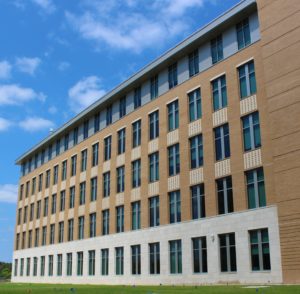Writer: Steve Byrns, 325-653-4576, s-byrns@tamu.edu
COLLEGE STATION – Sept. 15 marked the grand opening of the new Wildlife, Fisheries and Ecological Sciences Building at 534 John Kimbrough Blvd. on the Texas A&M University West Campus.
Dr. Mark Hussey, vice chancellor and dean of agriculture and life sciences at Texas A&M, College Station, said the $32.5 million building is the fourth to be constructed in the Agriculture and Life Sciences complex, a group of buildings housing staff “dedicated to feeding our world, protecting our environment, enriching our youth, improving our health and growing our economy.
“In September 1937, the Texas A&M University department of wild game was founded. Eighty years later, we open a state-of-the-art facility to continue eight decades of outstanding teaching, research and Extension outreach,” he said.
Dr. Michael Masser, wildlife and fisheries department head, said the opening will mark the first time all of the department’s faculty, staff and students are together in the same building since the 1970s.
New Texas A&M Wildlife, Fisheries and Ecological Sciences Building opens. (Texas A&M AgriLife Communications photo by John Chivvis)
“The building will bring more collegiality, cohesiveness and collaboration to the department,” Masser said. “The new building represents a major investment in our department and the ecological sciences department and will provide opportunities for increased research and the opportunity to attract new faculty and students because of the greatly enhanced facility.”
Dr. Kathleen Kavanagh, ecological sciences department head, said about one-third of her faculty will be located in the new building. They will gain high-end computing facilities for research and teaching, as well as four new labs for studies on global water modeling, wetland ecology, remote sensing, climate change biology and paleobiogeography.
The facility, Hussey said, includes two floors of state-of-the-art laboratories and 80,000 total square feet of space.
“Like the other buildings in the complex, it is built to LEED (Leadership in Energy and Environmental Design) silver standards. The building also connects to our rainwater capture system, which underscores our commitment to sustainability.
“A building constructed with sustainability in mind is a perfect home to two departments that work on the broad spectrum of environmental, ecology, wildlife and rangeland issues.”
Hussey said the wildlife and fisheries department combined program is the largest in the U.S. Additionally, the impact of the ecosystem science and management department is felt throughout the state with its faculty educating some 9,000 citizens at a number of educational events over the past year.
“This building gets us even closer to our ultimate goal of moving our departments together onto the West Campus,” Hussey said. “But what makes these buildings special is that they serve as a central home for one of Texas A&M’s founding colleges, the College of Agriculture and Life Sciences, and as a statewide hub for our agricultural agencies, the Texas A&M AgriLife Extension Service and Texas A&M AgriLife Research, whose 5,000 employees touch the lives of Texans daily. We live the land grant mission of close integration of teaching, research, Extension and service – and this complex is a commitment to continue that legacy into the future.”
The formal festivities ended with an official ribbon-cutting ceremony followed by a tour of the facility.
